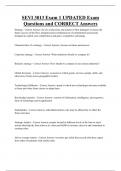SEVI 3013 Exam 1 UPDATED Exam
Questions and CORRECT Answers
Strategy - Correct Answer- the set of decisions and actions of firm managers to ensure the
future success of the firm; integrated and coordinated set of commitments and actions
designed to exploit core competencies and gain a competitive advantage
Characteristics of a strategy - Correct Answer- focuses on future and success
Corporate strategy - Correct Answer- What industries should we compete in?
Business strategy - Correct Answer- How should we compete in our chosen industries?
Global Economy - Correct Answer- economy in which goods, services, people, skills, and
ideas move freely across geographic borders
Technological diffusion - Correct Answer- speed at which new technologies become available
to firms and when firms choose to adopt them
Knowledge intensity - Correct Answer- consists of information, intelligence, and expertise;
basis of technology and its application
Stakeholders - Correct Answer- individuals/entities who may be affected by or affect the
firms outcomes
Strategic leaders - Correct Answer- people located in different levels of the firm to select
actions that help the firm achieve its vision and fulfill its mission; decisive and committed to
creating value
Above average returns - Correct Answer- investors get yields that exceed what they expect
from other investments with similar risks
,Key elements of Industrial Organizational (IO) model - Correct Answer- industry-based,
external environment, attractive industry, strategy formulation, assets and skills, strategy
implementation, superior returns
5 forces model - Correct Answer- threat of new entrants, rivalry among competing firms,
bargaining power of suppliers, bargaining power of buyers, threat of substitute products
Industry - Correct Answer- set of firms that produce similar products
Industry boundaries - Correct Answer- can change rapidly; helps executives determine the
arena in which their firm is competing
How strategic managers deal with changing industry boundaries - Correct Answer- be willing
to change your perception of industry and have multiple perceptions of your industry
Components of general environment - Correct Answer- ecological, economic, political,
sociocultural, legal, technological, global, demographic
Members of an industry - Correct Answer- industry and its buyers and suppliers
Suppliers of an industry - Correct Answer- set of firms that supplies raw materials to the
industry
5 Forces Model key objectives - Correct Answer- determines the future and current
profitability of the industry
Criticisms of IO model - Correct Answer- IO model makes the following assumptions which
are not realistic:
-There is only one strategy that can be successful in an industry.
-All firms can (and ought to) adopt the above strategy
Strategic groups - Correct Answer- set of firms following similar strategies
, Competitor analysis - Correct Answer- focuses on each company against which a firm
competes directly
Competitor analysis key elements - Correct Answer- capabilities, current strategies,
assumptions, future objectives, response
Resource based model key elements - Correct Answer- resources, capability, competitive
advantage, attractive industry, strategy formulation and implantation, superior returns
Resources - Correct Answer- broad in scope; cover a spectrum of individual, social, and
organizational phenomena
Capabilities - Correct Answer- bundles of resources or organizational capability to deploy
bundles of resources; allow an organization to perform certain aspects of its business well
Core competencies - Correct Answer- capabilities that are rare, valuable, imperfectly-imitable
/non-substitutable and organized to capture value
Tangible resources - Correct Answer- Relatively easy to identify, and include physical and
financial assets used to create value for customers
-Physical assets (Ex. plants & facilities)
-Financial assets (ex. cash & borrowing capability)
-Technoligical resources (ex.patents, copyrights)
-Organizational resources (ex. effective planning processes)
Intangible resources - Correct Answer- not easy to define and measure
-Human resources (ex. trust, experience, managerial skills, etc.)
-Innovation resources (ex. innovation capabilities, tech & scientific expertise)
-Reputation Resources (ex. brand names)




